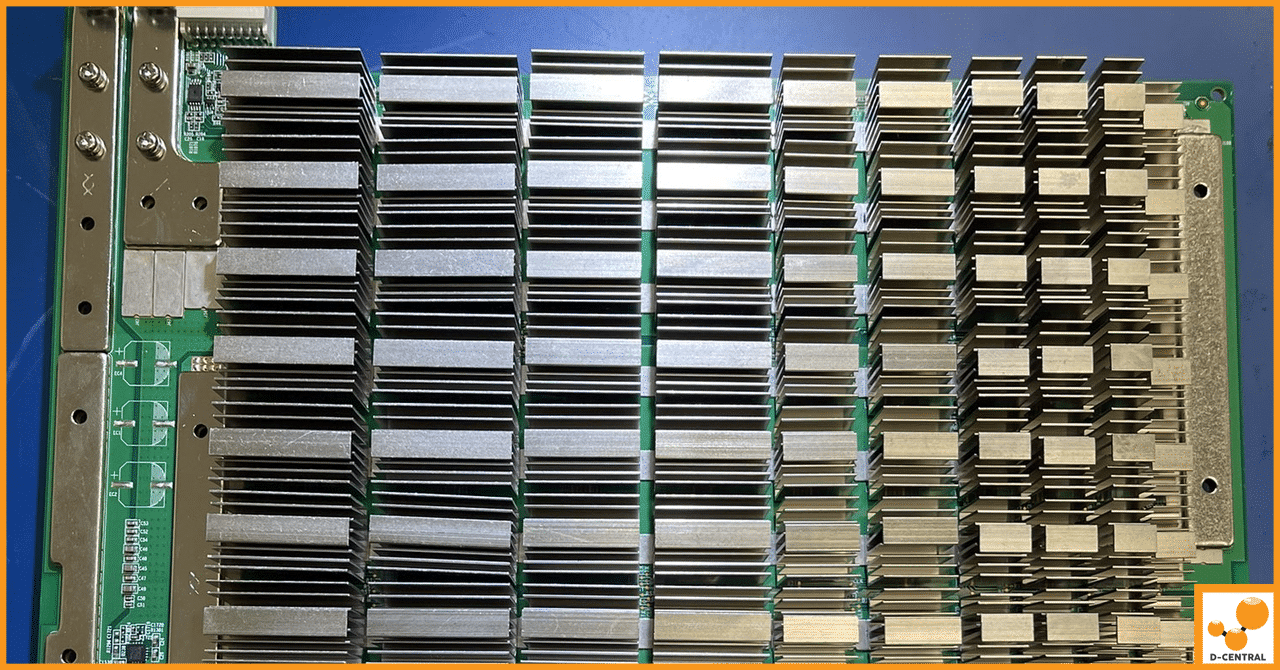
Bitcoin Mining Brings Energy and Revenue to Rural Communities
In the digital age, Bitcoin mining has emerged as a revolutionary process that underpins the functioning of the Bitcoin network.
4479 Desserte Nord Autoroute 440, Laval, QC H7P 6E2

The Antminer S19j Pro+ is a cutting-edge Bitcoin mining machine from Bitmain, a leading manufacturer of cryptocurrency mining hardware. This advanced model serves as an upgraded version of the Antminer S19j Pro, featuring a number of enhancements that have piqued the interest of miners worldwide. One of the most significant improvements in the S19j Pro+ is its upgraded performance and power efficiency. With a 10% increase in hashrate and enhanced power efficiency, this model is designed to provide miners with a competitive edge in the ever-evolving world of cryptocurrency mining. In this article, we will delve into the specifics of the Antminer S19j Pro+, examining its design, specifications, and heatsink performance, as well as comparing it to previous models in the series.
The Antminer S19j Pro+ model sets itself apart from its series counterparts due to a host of key design and specification modifications that raise the bar for mining performance. Of particular note is the implementation of single heatsinks for each ASIC chip, a novel design that has been met with mixed opinions from the mining community. Bitmain, the manufacturer of the Antminer S19j Pro+, claims that this inventive heatsink layout offers superior heat dissipation, but this claim has generated debate among miners.
The heatsink design of the S19j Pro+ model is a throwback to the design used in the Antminer S17 series. This decision initially caused some concerns among miners due to the S17 series’ issues with delamination. This was attributed primarily to the improper tinning of the chips during manufacturing. Nevertheless, it is important to note that Bitmain has undoubtedly learned from the shortcomings of the S17 series and has likely taken measures to address these issues in the design of the S19j Pro+.
As a result, the Antminer S19j Pro+ is expected to outperform its predecessors, with the new heatsink design reportedly running cooler than the screwed-on heatsinks of previous models. In fact, the S19j Pro+ has already shown promising results, proving that the new design can effectively manage heat and increase efficiency while reducing the risk of thermal issues. The combination of design improvements, informed by past experiences, should make the Antminer S19j Pro+ a more dependable and efficient mining machine. Ultimately, this will provide miners with a competitive edge in the constantly evolving realm of cryptocurrency mining.
Soldered heatsinks, as seen in the Antminer S17 and S19j Pro+ models, offer a strong bond and good thermal conductivity between the chips and the heatsinks. This design can lead to efficient heat dissipation and improved performance. However, the soldering quality is crucial, as poor soldering can result in issues such as delamination, which can cause poor heat transfer, high chip temperatures, low hashrates, and even chip damage.
The Antminer S17 models faced delamination issues due to inadequate copper tinning during the manufacturing process. This led to weak solder joints and delamination after just a few weeks of runtime, negatively impacting the mining efficiency and reliability of these models.
Glued heatsinks, as seen in the Antminer S9, offer a cheaper and easier-to-apply alternative to soldered heatsinks. However, glue has much lower thermal conductivity compared to solder, which can result in less efficient heat dissipation. Additionally, glued heatsinks can also experience detaching issues, similar to those faced by poorly soldered heatsinks.
Bolt-on heatsinks, used in other S19 variants, are attached to the chips with screws and use thermal interface material (TIM) such as thermal paste or pads to improve heat transfer. Advantages of bolt-on heatsinks include easier installation and removal, a lower risk of damage during transportation, and better compatibility with liquid cooling systems. However, bolt-on heatsinks also come with some disadvantages, such as higher costs, lower thermal conductivity than solder, and degradation of TIM over time.
A significant production change in the Antminer S19j Pro+ is the absence of a peripheral interface controller (PIC). The PIC is a microcontroller that typically manages input/output devices and communication among different components in a mining machine. This change has raised some concerns and questions among miners.
The lack of a PIC in the Antminer S19j Pro+ could have implications for the machine’s performance and servicing needs. Without a PIC, the machine rely on alternative methods for managing communication between components, which could potentially lead to reduced efficiency or increased complexity in addressing issues that may arise. Additionally, servicing and troubleshooting the mining machine might become more challenging for technicians, as they need to adapt to a different system architecture without a dedicated PIC to manage the device’s operations.
However, it is important to note that Bitmain may have implemented alternative solutions to address these concerns, ensuring that the Antminer S19j Pro+ remains a competitive and reliable mining machine despite the absence of a PIC. Further information from Bitmain or user experiences could provide better insights into the potential impact of this production change on the machine’s overall performance and maintenance requirements.
By learning from past failures, Bitmain may have improved the manufacturing process for the S19j Pro+, ensuring that the heatsinks are properly soldered and that the machine runs cooler than previous models. This could enhance the overall performance, efficiency, and reliability of the mining machine.
There may be other reasons for the production changes in the Antminer S19j Pro+ that are not yet publicly disclosed or well understood. Bitmain may have had specific design goals or faced constraints that led them to make these changes. Without official confirmation or detailed explanations from the company, it is difficult to determine the exact rationale behind these modifications.
The scope and potential repercussions of the production changes in the Antminer S19j Pro+ are still not entirely clear. Some changes, such as the heatsink design, could have a direct impact on the machine’s performance, efficiency, and reliability. Other changes, like the absence of a peripheral interface controller, might affect servicing and troubleshooting procedures. It is crucial for miners to keep themselves informed about the latest developments and user experiences to understand the full implications of these changes and make informed decisions when choosing a mining machine.
Several factors can influence the performance of heatsinks in a mining machine, impacting their ability to dissipate heat effectively. These factors include ambient temperature, airflow, humidity, dust accumulation, and power supply stability. A well-designed mining environment should carefully manage these factors to ensure that the mining machines remain cool and function efficiently.
Ambient temperature directly affects the cooling capacity of heatsinks, as they rely on the temperature difference between the components and the surrounding air. Higher ambient temperatures can reduce the effectiveness of heatsinks, leading to increased component temperatures and potential performance issues.
Airflow is crucial for carrying heat away from the heatsinks and maintaining an optimal temperature for the mining machine. Insufficient airflow can cause heat to accumulate around the heatsinks, reducing their cooling capacity.
Humidity can impact the performance of heatsinks, as high levels of moisture can reduce the thermal conductivity of the heatsink materials and create condensation that could damage the components.
Dust accumulation on heatsinks can act as an insulating layer, impeding heat transfer and reducing the cooling performance of the mining machine. Regular maintenance is necessary to prevent excessive dust build-up.
To evaluate the heatsink performance of mining machines, such as the Antminer S19j Pro+, it is important to monitor and compare the aforementioned factors with other models. By understanding how well a mining machine handles heat dissipation under various conditions, miners can assess the machine’s overall efficiency, reliability, and profitability.
Effective heat management is critical for maintaining the performance of mining machines and ensuring they operate at their full potential. A well-designed heatsink can help maintain optimal component temperatures, reduce the risk of overheating and damage, and contribute to the long-term success of a mining operation. By comparing heatsink performance across different models, miners can make informed decisions when choosing the most suitable mining machine for their needs.
Before setting up the Antminer S19j Pro+, it’s crucial to ensure that you have a suitable location with adequate power supply, ventilation, and cooling systems. Check the voltage and power requirements of the device and make sure that your electrical system can handle the load. Additionally, ensure that you have a stable internet connection to maintain uninterrupted mining operations.
The Antminer S19j Pro+ features a user-friendly interface that allows miners to monitor and manage the mining machine easily. The server provides real-time information on the mining machine’s hashrate, temperature, and other important parameters, making it easier for users to keep track of the device’s performance and troubleshoot any issues that may arise.
Setting up the Antminer S19j Pro+ server involves connecting the device to the power supply and network. Begin by connecting the power cables to the device’s power connectors and then to the power supply unit (PSU). Ensure that the power supply is switched off while connecting the cables. Next, connect the Ethernet cable from the mining machine to your router or network switch. Once all connections are made, switch on the power supply and wait for the device to start up.
To configure the Antminer S19j Pro+ server, you will need to access its web interface. To do this, first find the device’s IP address by checking your router’s connected devices list or using a network scanning tool. Once you have the IP address, enter it into your web browser’s address bar and log in using the default username and password provided by Bitmain (usually “root” for both).
After logging in, navigate to the “Miner Configuration” tab and enter the mining pool information, including the pool’s URL, worker username, and password. Make sure to save your settings and then restart the device for the changes to take effect. Finally, monitor the mining machine’s performance and ensure that it’s operating as expected. Make any necessary adjustments to optimize its efficiency and maintain a stable mining operation.
Selecting the right mining machine is crucial for maximizing mining efficiency, reliability, and profitability. Different miners have diverse needs and goals, which can influence their choice of mining hardware. Factors such as electricity costs, ambient temperature, available space, and level of technical expertise should be considered when choosing a suitable mining machine. By carefully evaluating these factors, miners can make informed decisions and select the best mining hardware for their individual requirements.
Miners who prioritize high hashrate and power efficiency might opt for machines with soldered heatsinks, such as the Antminer S19j Pro+. These devices can provide excellent thermal conductivity, which can improve heat dissipation and potentially lead to better performance. However, it is essential to consider the quality of the soldering between the chips and heatsinks, as poor soldering can cause issues such as delamination, which can negatively impact the machine’s performance and reliability.
For miners who prefer easier installation and removal, lower risk of damage during transportation, and better compatibility with liquid cooling systems, bolt-on heatsinks may be a more suitable option. These heatsinks are attached to the chips with screws and use thermal interface material (TIM) such as thermal paste or pads to improve heat transfer. While bolt-on heatsinks generally have a higher cost and lower thermal conductivity than soldered heatsinks, they offer advantages in terms of ease of maintenance, adaptability, and compatibility with various cooling solutions.
In conclusion, the Antminer S19j Pro+ holds great potential for making a significant impact on Bitcoin mining with its impressive hashrate, power efficiency, and improved heatsink design. It is crucial for miners to stay up-to-date with the latest developments in mining hardware to maintain a competitive edge. Ultimately, readers should carefully consider their options and choose the mining machine that best suits their individual needs, goals, and technical expertise. We welcome any questions or feedback and look forward to engaging with our readers.
What is the Antminer S19j Pro+?
The Antminer S19j Pro+ is an advanced Bitcoin mining machine developed by Bitmain. It serves as an upgrade to the Antminer S19j Pro, featuring improved performance and power efficiency.
What are the improvements in the Antminer S19j Pro+ model?
The Antminer S19j Pro+ model introduces several key enhancements that improve mining performance. One significant change is the implementation of single heatsinks for each ASIC chip, which provides superior heat dissipation.
What is the role of the heatsink in a mining machine?
The heatsink in a mining machine helps dissipate heat away from the ASIC chip, managing the chip’s temperature and improving its performance and efficiency.
What is the impact of the absence of a peripheral interface controller (PIC) in the Antminer S19j Pro+?
The absence of a PIC in the Antminer S19j Pro+ could potentially impact machine performance and servicing. However, it’s expected that Bitmain may have implemented alternative solutions to address this change, ensuring the mining machine retains its competitive edge and reliability.
How is the heatsink performance evaluated?
The performance of heatsinks in a mining machine can be evaluated by monitoring and comparing factors like ambient temperature, airflow, humidity, dust accumulation, and power supply stability. Effective heat management can contribute to long-term successful mining operations.
What considerations should be made when setting up and configuring the Antminer S19j Pro+?
You should ensure a stable power supply, ventilation, and cooling system when setting up the Antminer S19j Pro+. Additionally, a stable internet connection is necessary for uninterrupted mining operations.
What factors should be considered when selecting a mining machine?
Miners should take into account electricity costs, ambient temperature, available space, and level of technical expertise when choosing a suitable mining machine.
DISCLAIMER: D-Central Technologies and its associated content, including this blog, do not serve as financial advisors or official investment advisors. The insights and opinions shared here or by any guests featured in our content are provided purely for informational and educational purposes. Such communications should not be interpreted as financial, investment, legal, tax, or any form of specific advice. We are committed to advancing the knowledge and understanding of Bitcoin and its potential impact on society. However, we urge our community to proceed with caution and informed judgment in all related endeavors.
Related Posts

In the digital age, Bitcoin mining has emerged as a revolutionary process that underpins the functioning of the Bitcoin network.

Bitcoin mining is an integral part of the Bitcoin network. It’s a decentralized process where individual miners use specialized hardware

Bitcoin mining, a critical process for the cryptocurrency network, involves solving complex mathematical puzzles to verify transactions and secure the